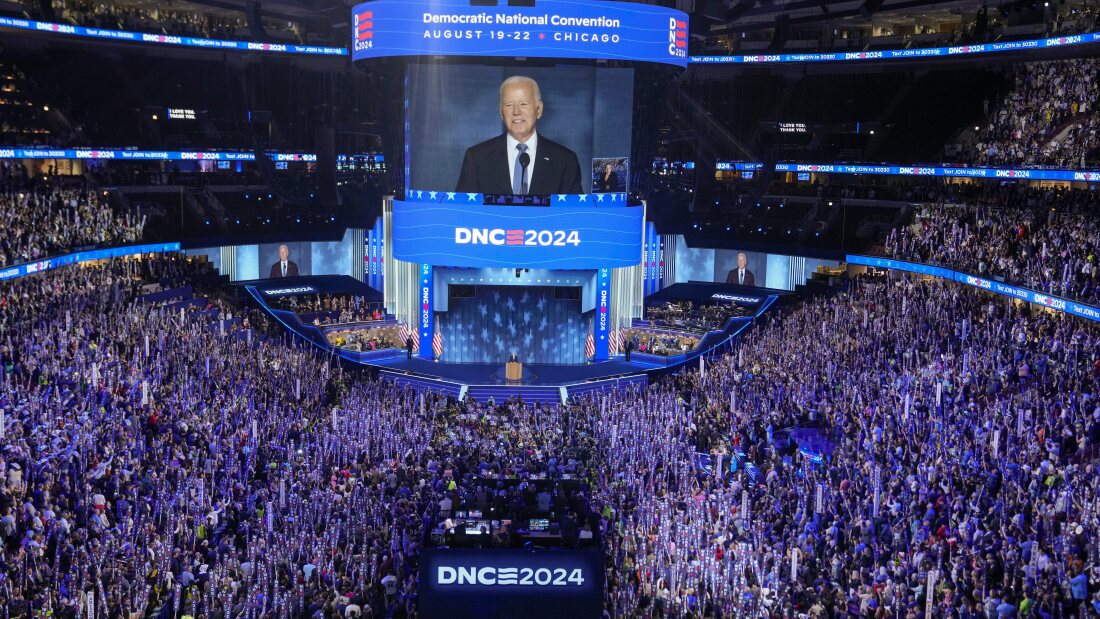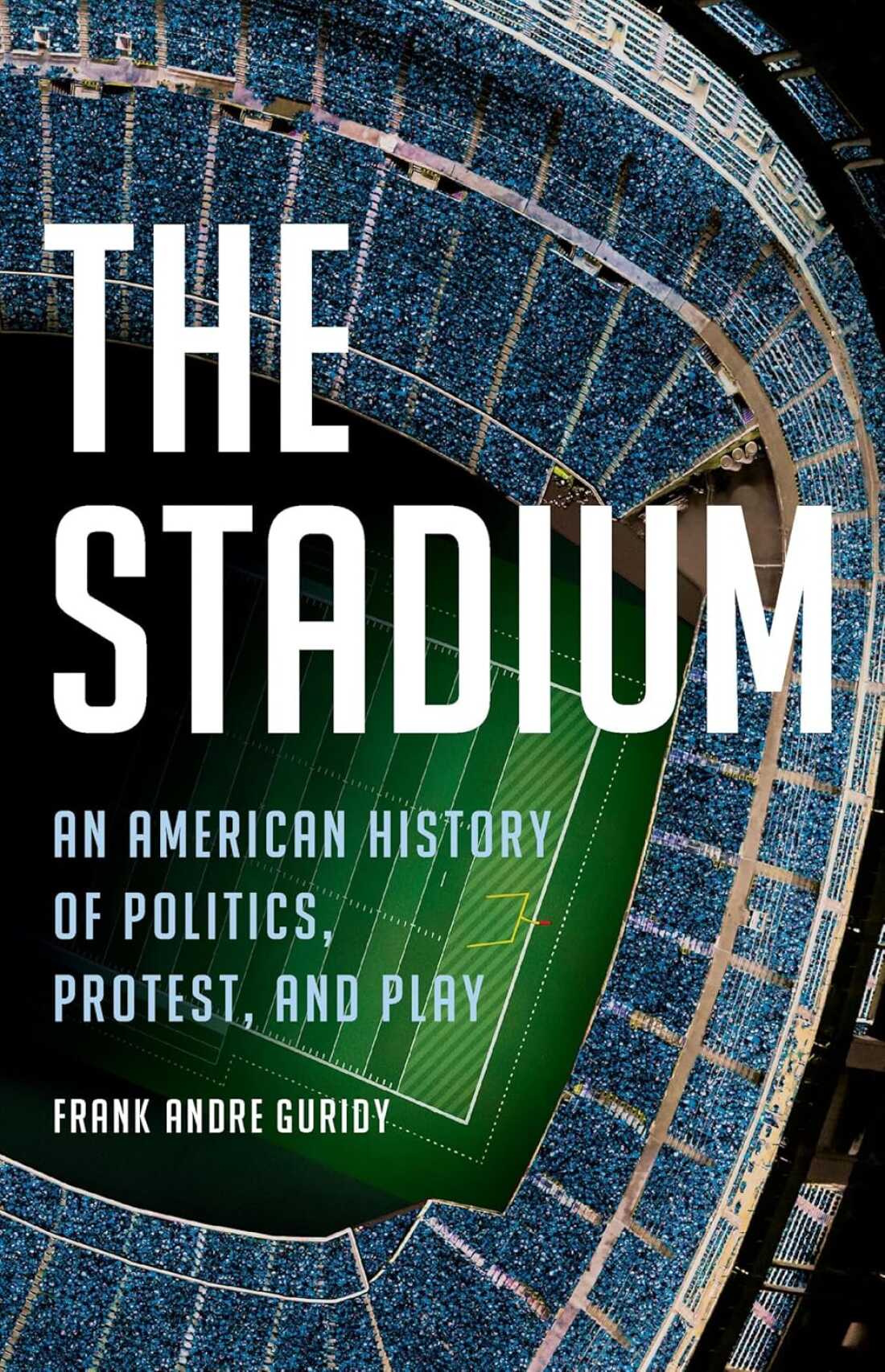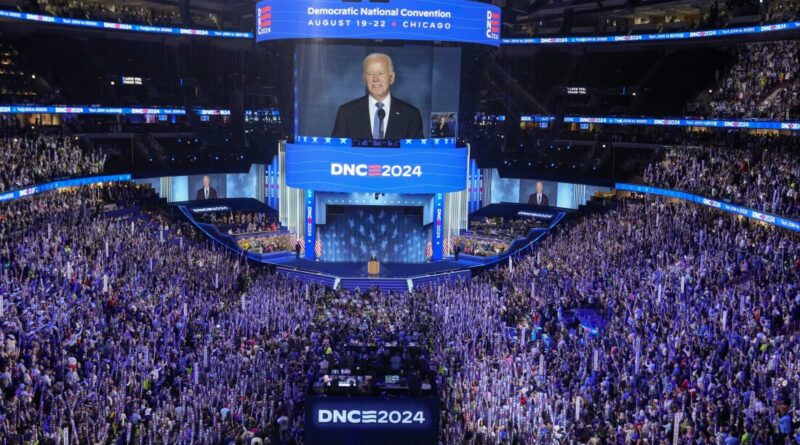As the DNC unfolds, a historian explains how ‘The Stadium’ became a public square

President Biden speaks during the Democratic National Convention on Aug. 19, 2024, at the United Center in Chicago.
J. Scott Applewhite/AP
hide description
toggle caption
J. Scott Applewhite/AP
On Monday night, nearly 50,000 people filled the Chicago United Center as President Joe Biden addressed the Democratic National Convention. Columbia University historian Frank Andre Guridy says these great monuments of sports, entertainment and politics serve as public spaces in American culture.
In his book, The Playground: An American History of Politics, Protest, and SportsGuridy chronicles the role that sports fields have played in American history and culture. From the 1920s pro-Nazi rally at Madison Square Garden, to Colin Kaepernick taking a knee in 2016 to protest police brutality, Guridy says stadiums are where Americans fight over race, class, gender and sexual injustice.
“We fight our political battles in the stadiums,” Guridy says. “Because they are big, because they can accommodate all kinds of people, … they become great places to put your claims on what you want the United States to be.”
Guridy says that the country’s first “playgrounds” – which took the form of circus tents or wooden football fields – appeared in the late 19th and early 20th centuries and were often sponsored by – businessman. However, in recent decades, there has been a trend towards tax-funded stadiums – although Guridy notes: “This idea that stadiums are places that help generate economy… [has] it was canceled time after time. ”

Guridy adds that as stadiums are being built or replaced, they are becoming commonplace, with corporate names and a cookie-cutter approach. “I would argue that a lot of these services feel out of place, because they all have the same kind of ad layout and the same kind of scoreboards, the same practices,” he says. ” “They all look the same.”
Discussion Highlights

Stadium
Porchlight Books
hide description
toggle caption
Porchlight Books
How the taxpayers paid for the new stadiums
Franklin Roosevelt’s New Deal helped start the process by which public funds built stadiums. … But it will be after World War II, when we see the strong growth of the sports and entertainment industry. When the United States really becomes a sports-crazy country, where sports franchises begin to make a case to politicians that … if you want to have a team in your city, you should build us a stadium of sports. And politicians are finding that they can make a lot of political money by bringing a major league team to town. And this led to the explosive growth of publicly funded stadiums in the 1960s and 1970s, and of course, to this day. …
Because sports are truly — and legally — alone in the United States, they can command that kind of power. It has been this kind of meeting between the old politicians and the sports league that has been able to suggest that the stadium is indeed something that should be supported by the public funds of the taxpayers. .
Part of the stadiums that were played in the country
Football stadiums like Ebbets Field [in Brooklyn] they become the sites of this great cultural and social and political change. Well, it’s not just because Jackie Robinson shows up wearing a Brooklyn Dodger uniform. That’s because people have been agitating for the rejection and abolition of Jim Crow for decades. … And we’re seeing this all over the country, especially in the South when … the college football field becomes this kind of sanctuary, this temple, that’s dedicated not only to football games, but to model and celebrating Jim Crow. The South and its perceived legacy of the Confederacy and slavery.
Sports fields until the middle of the 20th century, especially in the South, were white affairs, or indeed designed to exclude people of African descent and non-whites. But due to the influence of the freedom movements throughout the South and other parts of the country, we are seeing this great change happening publicly in the sports fields across the country. So Americans can hear that, live, at your station.
About how the American national anthem and flag became part of stadium culture

It begins at the beginning of the 20th century, where we begin to see performances of Francis Scott Key’s song in public spaces. But it wasn’t until 1931 that it became a national anthem, and in fact it wasn’t until the 1940s, that we begin to see a sort of regular performance of “The Star-Spangled Banner.” Banner” before games… not by accident. , after wars, after World War I, after World War II. And later, we start to see more and more songs like “America the Beautiful” and others that were made after 9/11, temporarily, not suddenly, where the United States is at war, when the US government must do so. of public loyalty to its citizens, and the football field and stadium become one of the places where that loyalty is cultivated.
About the militarized nationalism of the stadium culture, and Colin Kaepernick’s protest of police brutality in 2016.

When Kaepernick took a knee at Qualcomm Stadium [in San Diego] in August 2016, eight years ago, you, at that time, had 15 years of experience in jet aircraft. Fifteen years of honoring the military and law enforcement. And that’s the interesting thing after 9/11: The ways that, you know, military ceremonies become law enforcement ceremonies, yes [happens] almost immediately, in part because of the deaths among the first responders at the Twin Towers, but more than that. It becomes a strategy to push pro-police politics, I would argue, across the country. By the time Kaepernick is doing what he’s doing, it’s been 15 years since the expression of patriotism is weak and dissent is not tolerated in public.

Of course athletes have been bullied before Colin Kaepernick – most famously Tommie Smith and John Carlos when they did their Black Power salute at the 1968 Olympics in Mexico City. … But you see the complete intolerance and the accusations of Colin Kaepernick, which I would argue were unprecedented, and I think it’s because we’ve turned the stadium into a forum mainly for the military and for law enforcement. Just asking if any police action is intolerable, especially when a Black runner does it. …I think that’s why the theater becomes this fascinating theater, to look at the way we understand our world and American politics. And I really think there’s a much more oppressive political culture emerging after 9/11 than there was before.
The “Gay Games,” in part a response to homophobia in sports arenas

One of the most famous or infamous cases of [homophobia in a stadium] was the 1979 Demolition of the Disco event that took place in Chicago’s Comiskey Park, where a local disc jockey, Steve Dahl, decided to throw a party in the middle of a baseball doubleheader to break disco records. And this is when the anti-disco movement was emerging in the United States and [it] it was a very anti-homosexual movement. It was largely fueled by homophobia and racism. … The event turned into chaos where people charged the stadium and the games were cancelled. The second game of the doubleheader was canceled that evening in 1979 in Chicago.
So the football field becomes this battlefield, and … gay activists take their fight to the stadium, and they do so in San Francisco with the arrival of the Gay Games movement, created by Tom Waddell, among a host of other organizers, decide to create a kind of anti-Olympic competition … an athletic competition that showcased the talents of gay and lesbian athletes. And that’s what they did in San Francisco in the early 1980s. And their first Gay Games took place at Kezar Stadium, another community-run stadium in the summer of 1982.
About how the proliferation of VIP sections contradicts what stadiums were designed to do

The seating capacity is very small now, so you have large sections of the stadium dedicated to the VIP crowd, to the corporate crowd. And you have less space given to casual sports fans. And this is something that sports fans cry about often. And you can say, people can watch sports or watch whatever they want to watch on their device. But what we found in 2020 is that the fan is really important. … There were actually people writing articles before 2020 like: Do we really need fans in stadiums? And 2020 has shown that we need them. And that the athletes want them there and that the community wants to be there. …. Think of playgrounds as institutions. Think of them as places where, you know, people want to gather, for a good reason. And I think, it’s the best stadium when we really use it for that purpose. So why not open it up to more people?
Sam Briger and Thea Chaloner produced and edited this interview for publication. Bridget Bentz, Molly Seavy-Nesper and Meghan Sullivan adapted it for the web.
#DNC #unfolds #historian #explains #Stadium #public #square
